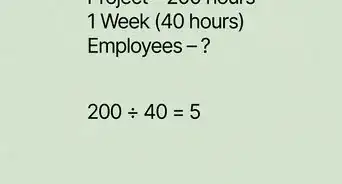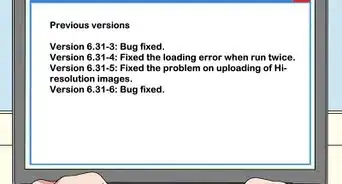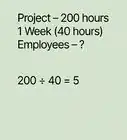This article was co-authored by wikiHow Staff. Our trained team of editors and researchers validate articles for accuracy and comprehensiveness. wikiHow's Content Management Team carefully monitors the work from our editorial staff to ensure that each article is backed by trusted research and meets our high quality standards.
This article has been viewed 20,284 times.
Learn more...
A project is a big responsibility, but you can make it easier to handle by planning it out in advance. This is done by identifying your project's goals and breaking them down into actionable steps. While staying aware of any budget or time constraints, you'll need to adjust your plans as the project takes shape. Then, by communicating with the project members, you'll manage the project to success.
Steps
Organizing Tasks
-
1Identify the project's goals. Take the time to describe the purpose of your project and what it will achieve. Write this on a whiteboard, computer document, or paper in a couple of sentences. Make the description as specific and easy to understand as possible.[1]
- One way to do this is to pretend you're writing a launch announcement for the finished product. Envision what the project will be like when you're done with it.
- For example,”build a house” is a very basic description. “Build a 3-bedroom glass beach house” is more descriptive and useful.
-
2Create a to-do list with the tasks you need to tackle. Come up with ways to accomplish the project's goals. Start with the big steps and list them under your goal. This will give you a basic idea of what you need to do. Break these steps down into smaller ones to make them more actionable.[2]
- It can be helpful to start with your vision of the final project and identify what you need to do to make it a reality.
- For example, if you're building a website, you need to make graphics, provide coding, and write the page's text.
- An actionable step might be, “Apply a filter to the picture of the elephant, then post it to the website.”
Advertisement -
3Go over the list with your team. Let your team look at the list and give their opinions. Many times they'll come up with more small steps needed to accomplish the ones you listed. Sharing these steps also ensures that everyone working on the project is on the same page.[3]
- One way to do this is to create a mind map. To do this, first list the large tasks, then draw "branches" linking them to smaller steps and ideas. Be sure to take a picture of the map or save the paper.
-
4Estimate the time requirement and cost of each step. Go back to each of the steps you listed and calculate what resources you'll use accomplishing them. Your guess won't be 100% accurate, but it should give you a sense of what is needed to finish the project. Remember that tasks your group hasn't done before take up extra time and money, so account for this.[4]
- You can research how much time and money a task takes by searching online and asking people who have done it before. For example, an expert coder can tell you how long it takes to create a new program for your website.
- It can be helpful to allocate a set amount of time to tasks that can go on indefinitely. For example, write, “We'll spend up to 20 hours creating the graphical layout.”
- If you're unsure of a step's costs, you can list how much time and money you're willing to set aside to complete the step. For example, write, “This section of our game world must be done within 2 months and cost less than $1,000.”
-
5Organize the tasks into a timeline. Now go back to your big list of steps and rearrange the steps into a working order. You can group the tasks into stages with deadlines, which is useful for keeping your team on track.[5]
- For example, when building a website, project stages or milestones might be building, designing, and testing.
- When you complete a milestone or stage, it can be helpful to acknowledge your team's work. Send them an encouraging message, buy them doughnuts, or by doing something else that inspires them.
-
6Assign tasks to the project participants. Decide which tasks your group members will work on. To do this, talk to each person to find their strengths and areas of expertise. You can also divide up some of the responsibility by having project members volunteer for different parts.[6]
- For example, you'd most likely want a graphics artist handling the project's visual aspect. You might then assign construction work to someone else.
Managing Deadlines Effectively
-
1Review the project's budget and deadline. Add up your time and cost estimates, then review the assigned tasks. You may see that the project is too big and complicated to complete in time and under budget, or you may not have enough people. You'll need to make changes to complete the project.[7]
- For example, you may only have a few weeks left to finish your video game. You'll need to finish the game, test it, and fix the bugs by hiring more people or delaying the release date.
-
2Move the deadline back if you can't finish the project in time. If you realize that you'll need more time to finish the project, tell the person who assigned the project. They may be willing to extend the deadline. It's important you ask right away so your team can adjust no matter what happens.[8]
- Remember that an extended deadline means the project costs more time and money. If this affects your project, make sure you factor it in.
-
3Bring in more people if the project needs to be completed faster. You may need to hurry to meet the deadline, or the project may still have unassigned tasks to fill. Ask the project organizer for help or find people who can take on some of the tasks.[9]
- In a business setting, more workers means the project costs more to complete. Make sure you are able to increase the budget to compensate.
-
4Eliminate some of the steps to complete the project faster. Sometimes your initial vision of the project isn't possible. Cut out some of the steps to focus on the project's important features. This will help you meet any budget or deadline concerns.[10]
- For instance, video game developers often have to cut features that are too costly or can't be finished before the game's release date.
-
5Decide on ways to fix worst case scenarios. Think about what's most likely to go wrong during the project. To plan for these, write down the ways you'll prevent these issues and deal with them if they arise.[11]
- For example, you might worry that the client will change the project at the last minute. To compensate, resolve to keep documentation of the work and provide frequent updates to the client.
Monitoring and Completing the Project
-
1Hold a kickoff meeting to begin the project. Meet up with your team one last time before beginning work on the project. Go over the plan together again to ensure that everyone knows what the project is and what's expected of them.[12]
- This is a good time to explain any expectations you have about status updates.
- This should not be the first time your team, bosses, or clients hear about your project plans. Keep them updated during the planning phase.
-
2Stay in contact with your team to monitor the project's progression. Your team should regularly update you on their work. Let them know that they should immediately tell you about any concerns or problems they have. You'll need to know these things so you can keep the project on track.[13]
- One way to do this is to pick a certain time, such as at the end of the week, to have a mandatory check-in.
- If a project member forgets to update you, reach out to them. Ask them how the project's going and what progress they've made.
-
3Update the client on the project's progression. Whether the project creator is a boss, buyer, or teacher, tell them about how the project is going. Send them a quick email or make a phone call when a major stage is completed or a problem arises. Good communication provides reassurance that the project is in good hands.[14]
- For example, a university professor may require you to submit milestone reports on your PhD project to ensure that the work gets done on time.
-
4Adjust the plan as needed to get the work done. Projects usually don't go perfectly, so you'll need to alter your plans. When a step can no longer be completed, figure out new ways to reach the end goal you envisioned earlier.[15]
- For example, you might adjust the deadline, adjust the budget, cut out some steps, or ask your team to do extra work today.
-
5Review the project and learn from what happened. When the project is finished, go back and look at your plans. Ask yourself what was good and bad about the project as well as what could have been done better. Decide if the project met your original vision for it.
- Ask your team for feedback. They'll most likely have a lot of insight for you that can improve your next project.
References
- ↑ https://www.techrepublic.com/blog/10-things/10-best-practices-for-successful-project-management/
- ↑ https://msdn.microsoft.com/en-us/library/aa480154.aspx
- ↑ http://www.telegraph.co.uk/finance/jobs/hr-news/8464466/Management-advice-How-to-manage-a-project.html
- ↑ https://www.cio.com/article/2378680/project-management/project-management-11-project-management-tips-for-setting-and-managing-expectations.html
- ↑ https://due.com/blog/how-to-manage-a-project-from-start-to-finish/
- ↑ http://www.telegraph.co.uk/finance/jobs/hr-news/8464466/Management-advice-How-to-manage-a-project.html
- ↑ https://www.techrepublic.com/blog/10-things/10-best-practices-for-successful-project-management/
- ↑ https://due.com/blog/how-to-manage-a-project-from-start-to-finish/
- ↑ https://www.cio.com/article/2378680/project-management/project-management-11-project-management-tips-for-setting-and-managing-expectations.html
- ↑ https://msdn.microsoft.com/en-us/library/aa480154.aspx
- ↑ https://www.cio.com/article/2378680/project-management/project-management-11-project-management-tips-for-setting-and-managing-expectations.html
- ↑ https://www.techrepublic.com/blog/10-things/10-best-practices-for-successful-project-management/
- ↑ https://due.com/blog/how-to-manage-a-project-from-start-to-finish/
- ↑ https://www.cio.com/article/2378680/project-management/project-management-11-project-management-tips-for-setting-and-managing-expectations.html
- ↑ https://msdn.microsoft.com/en-us/library/aa480154.aspx
About This Article
To manage a project, start by identifying the project's goals and the steps required to complete them. Then, assign team members to each task, such as making your graphic artist responsible for the project’s visual aspects. Next, hold a kick-off meeting to explain to your team your expectations for status updates. You should also keep the client updated on the project's progress through emails or phone calls. For tips on how to deal with problems, like running behind schedule and going over budget, keep reading!









































































